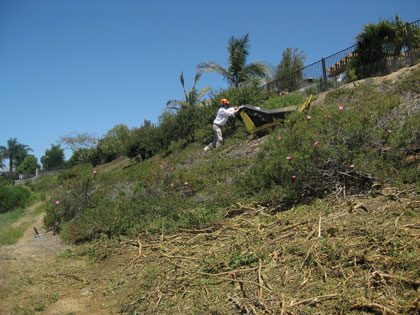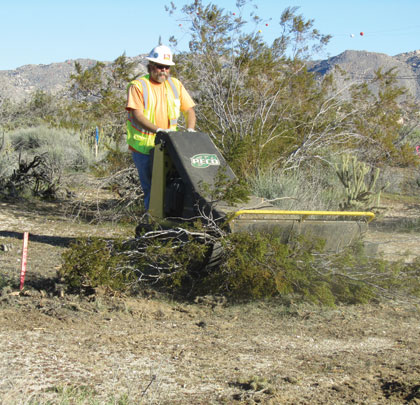Zero access. Not a road in sight. The middle of no-man’s land. Somehow, along a stretch between San Diego and El Centro in Imperial County, California, a power line with a series of 450 electrical towers had to be installed. This is normally a relatively routine project for a few contractors and an electric company, but this particular scenario involved several remote locations that were completely inaccessible other than by air.
San Diego Gas & Electric (SDGE) awarded the winning bid to an international contractor. Because each tower required clearing paths, roads and an approximately 100- by 100-foot pad, the contractor hired Colwell Equipment, Ramona, California, to perform the clearing before going in to install the towers.
Bill Colwell, owner of Colwell Equipment, and his brother, Ben, had a plan. Ben proposed setting up three six-man crews for the job, each equipped with brush cutters, a chipper, industrial weed eaters, and chainsaws.
THE PROJECT
Although at least half of the work would take place on privately owned property, the crews would need to meet several federal and state guidelines. For example, some stubble, or 2 to 4 inches of plant, needed to remain to help reduce wind flow and the potential for wildfire. Think of it in terms of rolling something across a tile floor versus carpet; the wind dies down eight times faster when stubble is present. So, essentially, the crews had to preserve as much vegetation as possible by trimming the areas that needed to be cleared and minimizing the environmental impact.
The state also specified and requested inspection of certain breeds of plants that were then to be removed and transported off site, and that was going to be a time-intensive and very costly process.
The Colwell brothers were in the early stages of developing a carrying system to transport the brush by helicopter to where it would be chipped up and discarded when they visited Mason’s Saw in El Cajon, California. The meeting dramatically changed the approach to the entire project. After just a few minutes of conversation regarding the clearing portion of the power line project, the owner of the shop, Paul Lasiter, recommended New PECO Inc.’s Brush Blazer.
In line with CAL FIRE and the California Department of Fish and Wildlife’s recommendations, the Brush Blazer would leave the right amount of stubble. After the state relaxed the inspections they originally demanded, Colwell coupled the Brush Blazer with an ELIET chipper also purchased from Mason’s Saw, which would allow the crews to cut and chip all of the trimmed material and leave it on site.
There was one catch. Although heavy-lift helicopters would be on the job, the general contractor wanted the cutting machinery to be transported in a K-MAX helicopter with a 1,500-pound lift weight. At 1,250 pounds, the Brush Blazers would leave just enough margin for the weight of the pilot and rigging cables. This would free the heavy-lift helicopters and sky cranes needed for transporting and setting up the towers.
Seeing it was a good potential match, Lasiter and the Colwell brothers took one of PECO’s units to the site for a demonstration.
Project areas were extremely hilly with sporadic ravines, terrain that makes building roads extremely difficult, if not impossible. Even if roads were built, they would be rarely used, as the population is very slim and even nonexistent in some areas. Hence, dozers would need to be helicoptered in to clear paths and level areas for the towers.
After calculating the amount of ground that needed to be cleared, Colwell purchased two Brush Blazers and developed the rigging to transport them from site to site. He used the machine’s crevices and nylon slings to rig up a four-point lift system. From there, steel braided cables reached an I-hook and were affixed onto the helicopter.

The Brush Blazer can propel up a hill with a 15 to 18 percent grade. This eases work for crews working in hilly areas, who otherwise would have to clear brush by hand.
THE ULTIMATE TAKEDOWN
The project kicked off in January 2011. The work was sporadic, put on hold for weeks at a time to pause for air clearance and the completion of the tower component manufacturing. Workers would then get the go ahead until the next hang-up, making the project a stressful and demanding “hurry up and wait” situation.
The self-propelled Brush Blazers cleared the pads and areas before the dozers were brought in. And, because the machine can propel up a hill with a 15 to 18 percent grade, it eased the work for the crews, who otherwise would have cleared brush by hand when the terrain was too steep or rocky.
“On terrain where the ground wasn’t so steep, in areas with heavy brush 1 to 6 feet high, one person operating the Brush Blazer could cut down the equivalent to what six to eight men with chainsaws and brush chippers could cut,” Bill Colwell shares. The Brush Blazers were capable of tackling everything that needed cutting on the site, he says, from wild buckwheat to cactus, from trees 3 inches in diameter to 1- to 4-inch material growing in clusters up to 11 feet wide.
Crew members would drop the Brush Blazers at a pad site, clear the brush, pick them up again, and move on to the next pad site. Meanwhile, they dropped the chipper onto the cleared pad to chip up recently processed materials.
Each tower required 10,000 square feet of pad, so at 450 towers, the crew needed to clear nearly 4.5 million square feet of land, or the equivalent of about 103 acres. Given a timeline of just 8 months, the crews had to clear more than 550,000 square feet, almost 12 acres per month, to finish on time—not including the paths and roads that needed clearing for easier access.
According to Colwell, the crews put in thousands of overtime hours, working six 12-hour days in a row on several occasions to cut brush, grade, and move thousands of yards of rocks and dirt. The Southern California job came to a close on time, despite the hang-ups, rough terrain, and extreme limited access. ■
For More Information For more information about New PECO, Inc. and its brush cutters, call 800.438.5823, or visit www.pecobrushcutters.com.
Modern Contractor Solutions, October 2014
Did you enjoy this article?
Subscribe to the FREE Digital Edition of Modern Contractor Solutions Magazine!



